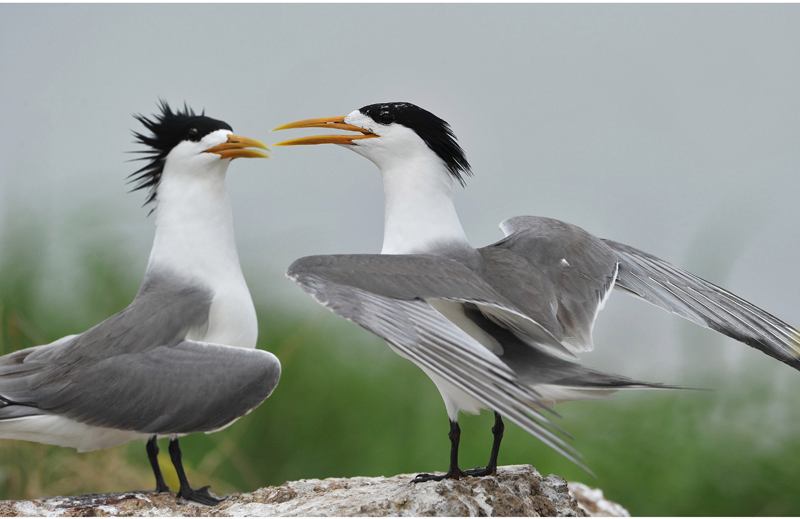Sterna bergiii
IUCN
LCBasic Information
Scientific classification
- name:Sterna bergiii
- Scientific Name:Thalasseus bergii,Great Crested Tern
- Outline:Wading birds
- Family:Charadriformes Ternidae C.Tern
Vital signs
- length:45-51cm
- Weight:170-250g
- lifetime:15 years or so
Feature
Crested, black on top of head and crown feathers in summer, white on top of head and gray on crown feathers in winter
Distribution and Habitat
It is found in Australia, Bahrain, Bangladesh, the British Indian Ocean Territory of Brunei, Cambodia, China, the Cook Islands, Djibouti, Egypt, Eritrea, Fiji, French Polynesia, Guam, India, Indonesia, the Islamic Republic of Iran, Iraq, Israel, Japan, Kenya, Kiribati, Kuwait, Madagascar, Malaysia, and Maldai F, Marshall Islands, Mauritius, Federated States of Micronesia, Mozambique, Myanmar, Namibia, New Caledonia, Northern Mariana Islands, Oman, Pakistan, Palau, Papua New Guinea, Philippines, Qatar, Saudi Arabia, Seychelles, Singapore, Solomon Islands, Somalia, South Africa, Sri Lanka, Sudan, United Republic of Tanzania United States, Thailand, Timor-Leste, Tonga, Tuvalu, United Arab Emirates, Vanuatu, Viet Nam, Wallis and Futuna Islands, Yemen.
Travellers: Jordan, Korea, Democratic People's Republic of Korea, Nauru, New Zealand, United States.
The Great Crested tern inhabits coastal and island rocks, cliffs, beaches and oceans.
Appearance
Large crested Tern: white forehead and eyes first. The top of the head is black to the pillow, and the top feathers extend back to form the crown feathers, which are also black in color. The hindneck and wings are white. Back, shoulders, wings and tail body dark pearl gray. The outer margin of the primary feathers is black, the inner is also black, but with a wide white wedge, which gradually shrinks towards the inner wedge until it disappears. Secondary feathers white insides and tips. The tail is dark pearl-gray, the outer tail feathers are longer, and gradually become pointed, and the tail is forked. Chin, throat, neck and lower body, including axillary and underwing coverts white. Winter feathers and summer feathers are roughly similar. But there are white stripes on the top of the head. The iris is dark brown. The mouth is yellow. The feet are black.
Juveniles do not appear to have breeding feathers, but have a dark yellow bill, a dark brownish crown that extends to both sides
Details
The Great Crested Tern has six subspecies.

Large crested terns are resident birds and often travel in flocks. They frequently fly over the sea, with their mouths pointing straight down, their wings stirring slowly, and sometimes soaring in the air, where they can search for and find underwater fish. When the fish is found, the two wings are closed, and suddenly dive into the water to hunt, and the wings rise immediately after the capture. Sometimes they float on the surface of the sea for long periods of time. Or bathe in the shallow waters of the sea. At night, it lives on overhangs or rocks on the shore. They feed mainly on fish. They also eat crustaceans, mollusks and other Marine invertebrates. Foraging is mainly on the surface.
The breeding season is from May to June. They often nest together and breed. Nest spacing is more than one meter. They usually nest on sandy or sandy ground with sparse dwarf plants near the sea. The nest is very simple. It is mainly by the parent birds to dig a shallow pit on the sandy ground without any inner cushion. Each clutch lays 12 eggs, occasionally 3. The color of the eggs is earth gray, white, off-white, milky white, or skin yellow, with reddish-brown or black-brown spots. The shape of the egg is pointed oval and the size is 58-66×40-45 mm, with an average of 58.7×41.8 mm.
Listed on the International Union for Conservation of Nature Red List of Threatened Species (IUCN) 2018 ver 3.1 - Not Threatened (LC).
It was included in the List of Land Wild Animals under State Protection that are beneficial or have important economic and scientific research value (Item 209) issued by the State Forestry Administration of China on August 1, 2000.
Listed in China's "National Key Protected Wildlife List" (February 5, 2021) Level 2.
Protect wild animals and eliminate wild meat.
Maintaining ecological balance is everyone's responsibility!








